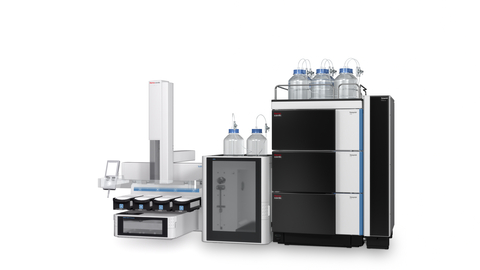SAN JOSE, Calif.– Thermo Fisher Scientific Inc., the world leader in serving science, enables clinical research, toxicology and anti-doping laboratories performing dried spot sampling and analysis to utilize a new automated sample prep and ultra-high-performance liquid chromatography (UHPLC) system to improve efficiency, robustness, sensitivity and sample traceability.
The new Thermo Scientific Transcend DSX-1 integrated sample prep and UHPLC system eliminates disc punching typically associated with dried matrix (spot) cards, and optimizes sample extraction and recovery of multiple matrices (e.g., blood, urine, serum and saliva). The new system enables laboratories performing routine analysis of drugs and other compounds to achieve substantial savings on time, labor and reagent costs compared to manual workflows. Proprietary flow-through desorption with heated capillary eliminates the need for manual, time-consuming extraction protocols and the automatic addition of an internal standard prior to the extraction minimizes matrix interference. Robustness and sensitivity are enhanced through online proprietary sample cleanup and enrichment via Thermo Scientific TurboFlow technology, producing confident results.
“Toxicology laboratories play a crucial role in detecting drug use and misuse in an ongoing struggle to safeguard society against increasing numbers of substances at ever decreasing concentrations. Dried spot analysis has emerged as a key technology in this area, requiring only a small amount of sample and, therefore, minimizing the user impact,” said Brad Hart, senior director, analytical vertical and life science mass spectrometry marketing, Thermo Fisher Scientific. “With the conventional workflow being held back by time-consuming manual procedures, we designed the Transcend DSX-1 system to ensure laboratories are able to effectively increase throughput to meet demand, while still ensuring the integrity and quality of results that are expected.”
Professor Mario Thevis, director for the Center for Preventative Doping Research, German Sport University, Cologne said, “Dried blood spot (DBS) tests have the potential to contribute substantially to an improved anti-doping testing program, today and in the future, supporting the clean athlete as well as the overall doping control analytical strategy. DBS analysis is the latest tool approved by the World Anti-Doping Agency (WADA) and was introduced at this year’s Winter Olympic Games in Beijing, China. In order to accommodate the specific needs associated with DBS analyses, and the considerable number of target analytes, robust, sensitive, programmable and especially automated DBS analytical options will offer critical advantages to anti-doping laboratories.”






